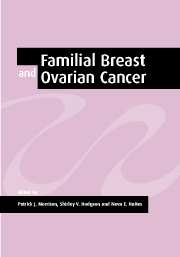Book contents
- Frontmatter
- Contents
- List of contributors
- Foreword by Helena Kennedy
- Preface
- Acknowledgements
- Part 1 Molecular biology and natural history
- Part 2 Screening
- Part 3 Management
- 15 Management of BRCA1/2 mutation carriers
- 16 Management of familial ovarian cancer
- 17 Prophylactic mastectomy in mutation carriers
- 18 Psychosocial aspects of genetic counselling for breast and ovarian cancer
- 19 BRCA1/2 testing: uptake and its measurement
- 20 Breast cancer genetics: ethical, social and insurance issues
- 21 Gene therapy for breast and ovarian cancer
- 22 Future directions
- Index
20 - Breast cancer genetics: ethical, social and insurance issues
Published online by Cambridge University Press: 24 August 2009
- Frontmatter
- Contents
- List of contributors
- Foreword by Helena Kennedy
- Preface
- Acknowledgements
- Part 1 Molecular biology and natural history
- Part 2 Screening
- Part 3 Management
- 15 Management of BRCA1/2 mutation carriers
- 16 Management of familial ovarian cancer
- 17 Prophylactic mastectomy in mutation carriers
- 18 Psychosocial aspects of genetic counselling for breast and ovarian cancer
- 19 BRCA1/2 testing: uptake and its measurement
- 20 Breast cancer genetics: ethical, social and insurance issues
- 21 Gene therapy for breast and ovarian cancer
- 22 Future directions
- Index
Summary
Background
A family history of breast cancer is now universally recognized as a potential risk factor, and demand for appropriate clinical services is fuelled by publicity in both the popular media and the professional literature. Within the past few years, breast cancer family clinics have sprung up in almost every major medical centre and all are hard-pressed to cope with the numbers of referrals (Thompson et al., 1995; Vasen et al., 1998; Hodgson et al., 1999). There has been little time to reflect on what constitutes an appropriate clinical service in this setting, while the pace of new developments on the molecular and epidemiological fronts has left clinicians struggling to interpret their relevance for patients. A critical reappraisal of the care currently offered to women who may be at increased genetic risk of breast cancer is therefore timely.
Are women misinformed?
Mammography and ovarian screening
Surveys in several countries have found that women coming forward to breast cancer family clinics want, above all else, access to mammographic screening (Julian-Reynier et al., 1996; Lalloo et al., 1998). For those judged to be above a certain level of risk, regular mammography is indeed usually provided, typically from age 30 or 35 years and at annual or 2-yearly intervals (Hodgson et al., 1999; Møller et al., 1999a). It remains the ‘gold standard’ for early detection of breast tumours but is far from perfect (Law, 1997). Data on the sensitivity of screening mammography for young women are very incomplete.
- Type
- Chapter
- Information
- Familial Breast and Ovarian CancerGenetics, Screening and Management, pp. 339 - 371Publisher: Cambridge University PressPrint publication year: 2002



